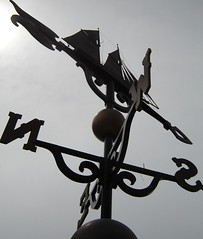
Weathervanes are a classic weather telling device. In days before the weather channel, these pieces of metal, posted on the top of the barn were exceedingly popular to have around. They would let the folks on the farm know if there was a storm coming their way. It was the only real clue the pioneers had as to what the weather was doing, and when the winds were shifting. They would use that information to make their own predictions on what kinds of weather may be coming their way.
But weathervanes go back far before the pioneer days and the Wizard of Oz, they go back to the times of Ancient Greece. In 48 B.C., there were weathervanes built to give the Greeks a clue to what was happening with the winds, one of them as a massive man-sized weathervane that was half man, half fish. They hoped to have some idea of the power of the winds, through their weathervanes.
Further forward in history, the Vikings also seemed to know a thing or two about weathervanes’ usefulness to tell weather. Theirs regularly had designs of Norse mythological animals and would be put on a ship so sailors could know what was happening in the atmosphere. On land, they were put atop Scandinavian churches.
But often you have likely seen the rooster as an animal on weathervanes. You may think that this is because of the old country influence, but it actually goes back much, much further. These rooster weathervanes became popular in the ninth century when the Pope wanted a religious reminder to adorn the top of the church. His selection was pulled from the bible, Luke 22:34, stating the morning after the last supper the cock would not crow until Peter denounced Jesus three times. Because of this verse, there are rooster weathervanes adorning chapels and abbey’s throughout Europe and beyond.
When it comes to the translation of the words weathervanes, you may actually picture something a little different. It is believed the word vane comes from the original ‘fane’ meaning flag in Anglo-Saxon. This would make sense, as through medieval times there were many flags and banners posted above buildings that would essentially serve the purpose of a weather vane. At some point, either because they grew tired of the wearing out of the cloth, or the cost to replace it, they moved to metal flags, some with coats of arms or other insignia, that were on posts where they could still shift and move with the wind.
Still today weather vanes are popular. While we may have better technology when it comes to predicting the weather, like Doppler radar instead of weathervanes, many still like the tradition of the pieces, and the antique look they bring to their home.
In many rural areas you can still find weathervanes in many designs from flags to ships, dogs, horses, and the famous rooster adorning homes and barns. While they may no longer need to be your only source for weather information, they are a great way to appreciate a blast of wind as they did in the past.
Tidak ada komentar:
Posting Komentar